Just a few months ago you were able to run a sub 48 min 10km, and then all of a sudden it hit you. Fatigue, running in pain, a constant battle with your weight, and a drastic decline in your endurance.
Running simply feels like hard work. If this sounds familiar, you’re not alone. The good news is that it doesn’t have to be that way.
I often get asked by peri- and postmenopausal women if menopause signals the end of their running…
…and the short answer is no.
You can continue running during menopause. By modifying your training routine, you can continue running longer and stronger through perimenopause well into post-menopause. In fact, numerous scientific studies have proved that running can actually help relieve menopausal symptoms.
I’ll dig more into those benefits a little later in this article, but first, let’s talk about menopause.

Why do we talk about “it” in a whisper? Why are we not shouting out and celebrating that we’ve reached this milestone in our lives? We’ve ended our menstrual cycles, no more PMS! Let’s change the narrative! Let’s stop society from making women feel like they’re losing something.
It’s not uncommon for postmenopausal women to feel empowered partly because of the biological changes that take place in menopause and because of the point in their lives when menopause occurs.
We Do However Need To Talk About Menopause & Running
Experts state that not talking openly about menopause is a mistake, the more openly women chat about how they are feeling and what they are going through, the less stress they will feel as they traverse the physical and emotional changes that come with menopause and the more likely they are to realize that they are not alone.
So, on that note, before we dive into how you can keep running well during menopause, let’s touch on the different stages of menopause so that we know how it affects your running…
The Different Stages Of Menopause
Menopause can be broken down into 3 distinct phases:
- Perimenopause
This is the transitional period before menopause. Perimenopause can last for around 4 years but can be anywhere from months, for some women up to 8 years! When you go a full 12 months without a period, menopause has begun.
During this stage, a woman’s estrogen levels will drop. Before the estrogen levels drop (and then flat-line completely) they (along with progesterone and other hormones) fluctuate.
They no longer have a cyclic action like they used to and this is the reason for symptoms like hot flushes, irregular periods, heavy periods, insomnia, night sweats, etc…
- Menopause
Menopause is defined as a single point in time.
It is the point at which you have not had a period in 12 months. Everything before that is considered perimenopause, everything thereafter is menopause.
- PostMenopause
A woman is post-menopausal during the years after menopause when she is no longer ovulating. This is when Estrogen and other hormones continue to get lower until eventually flatline
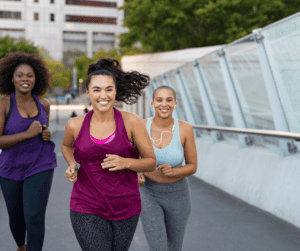
There are tons of women out there who are worried that running can bring on early menopause.
We hear countless questions like: “Is it safe to run during menopause?” or “How do I run during menopause?” And even, “How will my athletic performance be affected by menopause?”
Let’s deal with one of the biggest misconceptions about running concerning menopause…
Does Running Cause Early Menopause?
It is definitely a valid concern but the truth is that running does not cause early menopause.
The amount of physical activity, including running, that women undertake is not linked to their risk of early menopause, according to the largest study ever to conduct this investigation.
Early menopause happens when a woman’s menstruation cycle ends before the age of 45 and it can happen naturally or as a side effect of various treatments. Some reasons include premature ovarian failure, cancer treatments, and surgeries to remove the ovaries.
With all of that said, let’s dive into what happens to your body when you run during menopause.
What Happens To A Runner’s Body During Menopause?
There is no doubt our bodies are changing during this phase of our lives, so it goes without saying that these changes are going to impact our running performance.
Here are some of the things that will affect your running as you go through menopause:
- Slowing Down
- Weight Gain
- Incontinence
- Hot Flushes
- Night Sweats
- Insomnia
- Emotional Changes
Slowing Down
We get slower as we get older. There are several factors as to why this is the case but the first two are key. The first reason is due to a loss of strength and the second is hormonal fluctuation.
Firstly, we start to slow down because of a key loss of strength, essentially we start the aging process in our third decade of living, but when we get to around 50, We lose muscle mass as a natural function of aging. Therefore losing strength.
Secondly, your hormones are out of control and eventually flatline – sounds a bit melodramatic. But from the female athletes we’ve worked with, we know that this is how they feel.
When you are in perimenopause your hormones are fluctuating and there is no cyclical action, so eventually, they flatline, these hormones play an important part in your muscle synthesis, and as a result, your running performance. So that’s why we start to run slightly slower.
An important factor to consider is strength training and it’s a topic we will delve into a bit later. If we don’t make time for strength training, we have a higher chance of getting injured, which is also a contributor to running a bit slower.
Editor’s note: If you’re currently not doing any strength training, now is the perfect time to start. We’ve put together a free strength training plan that you can do twice a week, at home without any expensive equipment. You can click here to download it now.
Weight Gain
Weight gain during menopause is very common. It occurs before and during menopause because of the drop in estrogen levels and because we become a bit more insulin resistant, this is the reason running doesn’t always help with weight loss anymore and why we tend to pick up that “belly fat”.
There is a big misconception out there about gaining weight during menopause because of age-related reductions in metabolism, but…
This is no longer true… A recent study released last year disproves this theory. It states that our metabolisms (men & women) decline after age 60 by about 0.7 percent a year.
Effects Of Weight Gain On Your Running:
- Increased heart rate
- Increased body temperature
- Increased energy expenditure
If you’re interested in changing your life, improving your cardiovascular health, building confidence, connecting to nature, and increasing your longevity…It’s not the craziest idea…Running will help you to do just that. See how here.
Incontinence
This is one that no one tells runners going through menopause about and one that people don’t really want to talk about, which is exactly why we’re talking about it.
Urinary incontinence (UI) is also known as “loss of bladder control”. Many women experience this and think it’s normal. It’s NOT normal, it’s extremely common, not just in women going through menopause but can also be experienced due to other reasons… it should not be considered normal.
The loss of control can be very minor. You might only leak a few drops of urine when you laugh or run. The loss of control can also be major, you might experience a sudden urge to urinate, and being on a run (away from a bathroom) may result in an accident.
Urinary incontinence is very common but the good news is that is preventable if treated correctly.
If urinary incontinence is something you’re battling with, I’d highly suggest you see a physiotherapist that specializes in women’s health issues. Getting your UI under control will literally change your life and brings heaps of joy back into your running without the embarrassment of Urinary Incontinence.

Hot Flushes
Anyone going through menopause knows that hot flashes/flushes are the absolute WORST!
Hot flashes are the most common symptom of perimenopause and menopause and are due to a misregulation in thermoregulation due to the fluctuation of hormones Estrogen & Progesterone.
There are no outright solutions to this… If I had the answer, I’d be sitting on my island drinking cocktails all day.
So the only advice we can offer for hot flushes is this:
- Layer up so you can remove layers
- Always run with or near water sources
- Try and pick up triggers/trends for hot flashes so that you can avoid running in those, eg. afternoon heat
Night Sweats
Night sweats are when you experience excess sweating during the night. These are one of the most common and intense symptoms of menopause, with two-thirds of women experiencing them.
They can be so severe that you wake up and can’t get back to sleep.
Not having a good night’s sleep means you have a slower recovery time from your runs. Interrupted sleep and lack of sleep have been proven to increase injury risk, and illness risk (less than 7-8 hours!).
Also when we’re sleeping there’s a release of specific hormones like growth hormone and testosterone which aid muscle growth and muscle synthesis.
Sleep is one of the non-negotiable pillars of recovery, training, and ensuring you get to the next workout feeling good. In this article, we discuss ways to improve the quality of your sleep.
How To Prevent Night Sweats:
- Choose breathable fabrics (PJs & sheets).
- Make your bedroom cooler.
- Drink a small glass of cold water to lower your body temperature before heading to bed.
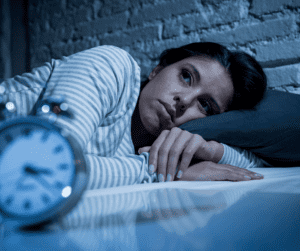
Insomnia
You can’t fall asleep, you can’t stay asleep and you’re certainly not getting enough sleep.
Sleeping (or not-sleeping) with menopause:
A normal night starts with me feeling tired, crawling into my comfy bed, and falling asleep. Only to wake up again. My mind is running. Wide awake. Hot flush. Need the bathroom. Not comfortable. Bonus: Hot flush number 2! Kicking the covers off. Trapped in my covers. Finally, Sleep. Wait. It’s time to wake up already. Time to run…..what! I’m supposed to Run??
A study published in the Journal of Clinical Sleep Medicine found that regular exercise, like running, can improve the quality of your sleep and help you sleep through the night.
It may sound like a difficult task but running will make a world of difference to your sleep pattern and your sleep pattern will make a world of difference to your running.
There is an important release of hormones when we sleep that aid our recovery as a runner and if we’re not sleeping well, it’s going to have a huge impact on our running.
I know it’s easier said than done, but getting to bed at a reasonable hour (before 10 pm) should always be the number 1 goal when it comes to sleep. Try and stay off devices like computers, TVs, or cell phones for at least an hour before heading to bed.
Ensuring good sleep hygiene is important too. Make sure the room that you sleep in is cool and dark and that there aren’t any lights from tvs or electronic devices.
Emotional Changes
Going through menopause can often feel like a rollercoaster. One minute you’re feeling great, the next, not so much. Again, it’s important to know that this is normal and it will have an impact on your running.
Some days you’ll feel like you can’t wait to head out for your run, others you’ll be dreading the fact that you need to lace up for a high-intensity track workout. I’ve worked with athletes that find themselves sitting in their car crying before going to work or before a run…
Be kind to yourself and don’t put yourself under pressure.
In the 1930s they used to put women into mental institutions when going through menopause… Not that long ago!
Thank goodness science has evolved and they have figured out that the mood swings and effects on women’s mental health (depression/anxiety) are due to the loss in estrogen affecting the movement of Troponin moving across the blood-brain barrier which affects serotonin levels.

Some of the emotional changes experienced by females undergoing perimenopause or menopause include:
- Irritability
- Anxiety
- Aggressiveness
- Sadness
- Mood changes
- Depression
I would suggest that these aspects can help: exercise, eat healthily, find a calming self-practice for yourself (like yoga), avoid alcohol, and nurture your relationships with your family and friends.
However, seeking assistance from a medical practitioner/psychologist is key. As they can prescribe medication to assist in these times
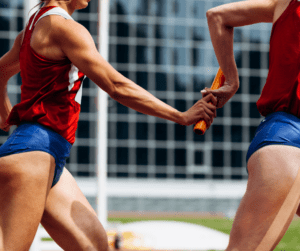
Now that you understand the changes that are going to happen or the changes that are happening to your body as a runner during menopause … here’s how you should be training as a peri- or postmenopausal runner.
How To Adjust Your Training When Running Through Menopause
So now that we know what we’re dealing with as a peri- or postmenopausal runner, let’s dig into how we should be training.
There are 5 specific areas that peri- and postmenopausal runners should be focusing on if they want to continue running pain and injury-free for years to come.
The first is recovery…
- Recovery For Menopausal Runners
Recovery is important across the board, but it becomes even more important as we get older.
People often think that it’s when you’re running or when you’re doing that session, that you’re getting fitter or stronger.
That is not the case.
You only get that gain of fitness, when you’re recovering from doing that run.
What’s essentially happening is as you’re running, there’s a bit of systemic failure and muscle breakdown.
The body breaks down, it doesn’t like what you put it through, so when it’s resting it makes itself stronger, and that’s how we get fitter and stronger.
(If you want to learn more about recovery and how it impacts your running then watch this video: Here)

In a nutshell, this is how it works…
During the run, your body breaks down, and then afterward, while you’re recovering it builds itself back to where it was and then some so that it’s not left wanting the next time you run.
And that is exactly how you become fitter, faster and stronger.
Ensuring you recover correctly allows you to show up at your next training session feeling even fresher & stronger than before.
As we get older though, we do need more recovery.
We can’t train the same way we did in our 20s and 30s either, because when you’re in your 20s and 30s, your hormonal structure was so cyclic. Now as I mentioned, it’s all over the place.
A lot of scientific research has also been done to prove that women have an entirely different hormonal structure compared to men. So the way we should be training as females should be slightly different from the way men train.
It is for this reason that we have to readjust the way that we train. A lot of that comes down to the way we structure our running training.
Many times what you leave out is more important than what you put into your run training.
REST is a four-letter word that most runners don’t want to hear, and should be seen as important as your interval session or long run
That is why in our experience here at Coach Parry, having worked with thousands of menopausal runners, the vast majority of menopausal runners thrive on no more than 4 days of running a week.
Rest days are as important as the days you run in your training plan.
That then leads us to the next question we get asked all the time:
How do you know you’ve recovered sufficiently?
There are a couple of ways we like to monitor recovery. The first and easiest is subjective, asking yourself “How do I feel?”
Are you constantly tired? Are your legs feeling heavy? Your answers should give clear indications as to if you are fully recovered. If you’re walking up a flight of stairs and you get to the top and your legs are heavy and you don’t feel good, then you’re not recovered.
The second is to track your resting heart rate daily. It’s important to note that you’re not chasing a specific number here, you’re more interested in the trend.
If you notice a slight increase (approximately 4- 8 beats per minute) over a 2- 5 day period, that is a red flag. It could be your body not coping with the load, it could be stress, or it could be an infection… So you should back off slightly with the intensity or take a rest day.
If the increase is higher, that is a sign that you need to rest completely or risk heading towards overtraining, illness, and eventually injury.
We put together A Practical Guide To Running Recovery, you may find this helpful because allowing yourself time to recover after your runs is what makes it possible for you to come back better adapted for your next run.
That leads us nicely to the second area that runners going through menopause often get wrong…

- What pace should you run at when going through menopause?
This is the single biggest mistake we see runners that are going through menopause making and that is that they run their easy and long runs way too fast.
I know that in today’s day and age, we’re all pressed for time. With demanding careers, busy families, and lives generally running to a tight schedule, it’s often very difficult to get time for ourselves.
When we do get time for ourselves and head out for a run, we feel like we need to get the biggest bang for our buck for the time we’re putting in.
If you’re not working hard or busting a lung, you’re not benefitting fully from the training you’re doing. But now you also understand from RECOVERY that you don’t get the benefit in the session, it happens in recovery so why break yourself doing it.
To improve endurance we need to run in the correct “zone”. This refers to the intensity we run at. That’s where the body becomes more efficient (You become a better runner).
This range is very wide though. You can run in the faster end of the range = lots more eccentric stress and load on the body or you can run on the slower end = with much less stress on the body.
Recreational runners, males, and females are constantly trying to prove to themselves in their running sessions that they’re getting better.
This Is The BEST Way To Improve Your Running Pace
So that begs the question, how easy is easy?
How Easy Is Easy On Your Easy & Long Runs?
Training at the correct pace is so important because when we are running in the correct zone, that essentially is when we are getting all the physiological adaptations that we need.
Zones can differ in different theoretical models that you might look at, it might be a three-zone model, we work off of a five-zone model at Coach Parry.
Essentially, the zone is where you’re getting all the physiological adaptations that you need for endurance running. Physiological adaptation, meaning, your heart as a muscle, because the heart is a muscle that gets stronger, it gets bigger as well. So it becomes more efficient in circulating blood around your system.
When you’re running within this zone, you can run towards the top end of that zone, which is a little bit faster, or the bottom end. When you’re running at the top end of that zone, you’re putting a lot of eccentric stress on your muscles.
You can run at the bottom end of the zone and then there will be less of that load of eccentric contraction and less wear and tear on the body. You’re going to be getting exactly the same benefits as if you were running toward the top end of that zone.
It’s also important to say that not every run should be easy. Do your easy run easy enough so that when it comes to doing the harder, higher-intensity sessions, you’re good to go.
If you’re running your easy runs easy enough, you’ll start seeing an immediate improvement in your running.
The next area I’m going to cover may take a little bit longer to bear fruit, but it will have a huge, positive impact on your running longevity in menopause.
- Strength Training For Menopausal Runners
As we reach around the age of 50, we notice that there’s this exponential loss of strength and that’s really why we start getting slower as a runner.
Bone mineral density does not decrease due to loss of strength, it decreases due to estrogen no longer helping the bones absorb calcium…
BMD improves with resistance training.
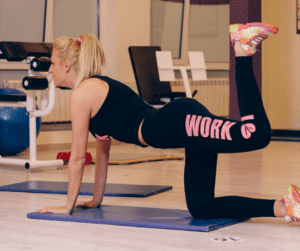
During menopause, your estrogen is fluctuating and no longer plays the role of helping your bones to absorb calcium. Bones require a load on them to absorb that calcium and get stronger.
Yes, running is placing a load on your bones but your bones require a multi-directional load on them to really help that mineral bone density. This is where resistance training comes into play.
Resistance training can reverse some of the ageing processes and increase your lean muscle mass. Pushing your body against a form of resistance can be Bodyweight, bands, weights, etc… The load on the bones from the resistance is what improves Bone mineral density.
If you want to stay injury-free and keep running to and through menopause, then strength training is non-negotiable.
(The good news is we’ve created a free strength training plan specifically for women who are wanting to run to and through menopause. You can download that plan by clicking here.)
The key however is in the type of strength training that you are doing…
The type we are talking about that is vital for peri- and postmenopausal women is resistance training and high-intensity interval training.
These are important because you require the impact of resistance training for your bone mineral density. The reason high-intensity interval strength training is important is that when our estrogen starts to flatline, we start becoming a lot more insulin-resistant. This contributes to women with menopause not being able to lose weight easily.
- Menopause & Running Nutrition
As menopausal runners, nutrition is key because we don’t ever want to find ourselves with low energy availability. This is common because most females are trying to restrict their diet due to weight gain. But this is actually counterproductive…
Women have gotten the message they should always eat less, even when they’re moving more.
We LOVE this article and couldn’t agree more!
Check it out!
We’ve spoken about better managing body composition and protecting bone health. Strength training and nutrition are there to help you manage these two and help improve them as you’re going from perimenopause to menopause to post-menopause.

When we want to resynthesize muscle and have a good recovery, we need to have a good protein and carbohydrate intake to replenish muscle glycogen after running. Increasing your protein intake in this phase of your life is absolutely vital because when you increase your protein intake over 24 hours, it improves your muscle protein synthesis (rebuilding the muscle).
When you increase that protein intake, and you add resistance training, what this all does is increase your anabolic window, when you are exercising it’s catabolic for up to four hours.
You should increase your protein intake over 24 hours, an easy way to do this is to increase your intake around your sessions by making sure that you’re taking good carbohydrates and protein sources after your training session.
So 20 to 30 minutes after your training session, you should consume a good protein source, generally, not at the expense of other carbohydrates, you should ensure that you are still getting good carbs so that you don’t fall into low energy availability.
Let’s have a look at what exactly happens in your body while you run with a full tummy as well as what and when you should eat to feel great during your runs. Read about it here.
- Running Consistency & The Menopause
It’s easy to confuse consistency with discipline when we talk about running. In this case, we’re not talking about the discipline we need to get out on the roads or trails and run…
When we talk about consistency we mean doing the right things over and over for a prolonged period.
The best way to understand consistency is to think of this consistency as a financial investment. When you save a little bit of money month after month, it started compounding the longer you invest.
Now apply the same thought process to your running. Basically what you would do is build layers upon layers.
Imagine there is a block in front of you, this block represents three weeks of training that you have managed to complete consistently. You do that again and you get another block in front of you. You’ve stuck to all four of the other pillars and you keep going on and on and on – Fantastic right? You end up getting stronger and stronger and you get to race day and everything works out incredibly.
The converse is obviously also true…
You’re not running your easy runs easy enough, which means you’re not recovering from all of your sessions. You’re also feeling tired so you give your strength training a skip because running is the most important part of your training, right?
You then wake up one morning with a sore knee but you head out anyway because you have a track session and before you know it you’re forced to miss a few weeks of running due to an injury.
When you come back to running you try and pick up where you left off and suddenly jump right back to where you were. But you’re getting older, so you don’t bounce back the same way you used to. You’re still getting fitter, but now your entire structure is rickety and wobbly.
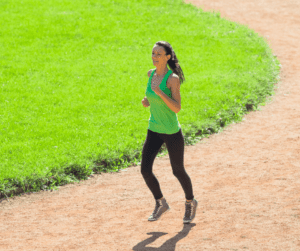
Now imagine an entirely new structure, where there are evenly placed gaps between the blocks.
There are gaps because there doesn’t have to be that consistency like in the first structure.
You don’t want your structure to crumble, the goal is to build layer upon layer, time after time to get the training effects that we need.
That is what consistency can do for your running.
Let me touch on the issue of hormone replacement therapy and running…
Does Hormone Replacement Therapy (HRT) Make a Difference To Your Running Training?
Every single female is going to react differently to Hormone Replacement Therapy. It’s important to note that we are not providing medical advice, so this is a topic you should please consult your physician about.
Hormone Replacement Therapy can have a very good effect on your postmenopausal and your menopausal symptoms, but not necessarily on your running training. It’s still crucial that you follow the correct training principles, even if you are on HRT.
The hormone that you’re replacing it with is not exactly the same, unbelievable scientific research has gone into making estrogen microbiologically, but it’s not the same as your estrogen. Therefore it doesn’t have the same effect on your bone mineral density & lean muscle mass.
HRT could do wonders for your symptoms, but it’s not going to affect your running training in the positive ways that we need. The way to positively make a difference in your training is to follow the five pillars in the framework above.
Discover how you can run better as you get older, without training more or harder than you currently are… in our upcoming Running Through Menopause Masterclass with Sports Scientist Shona Hendricks. Save your seat below:
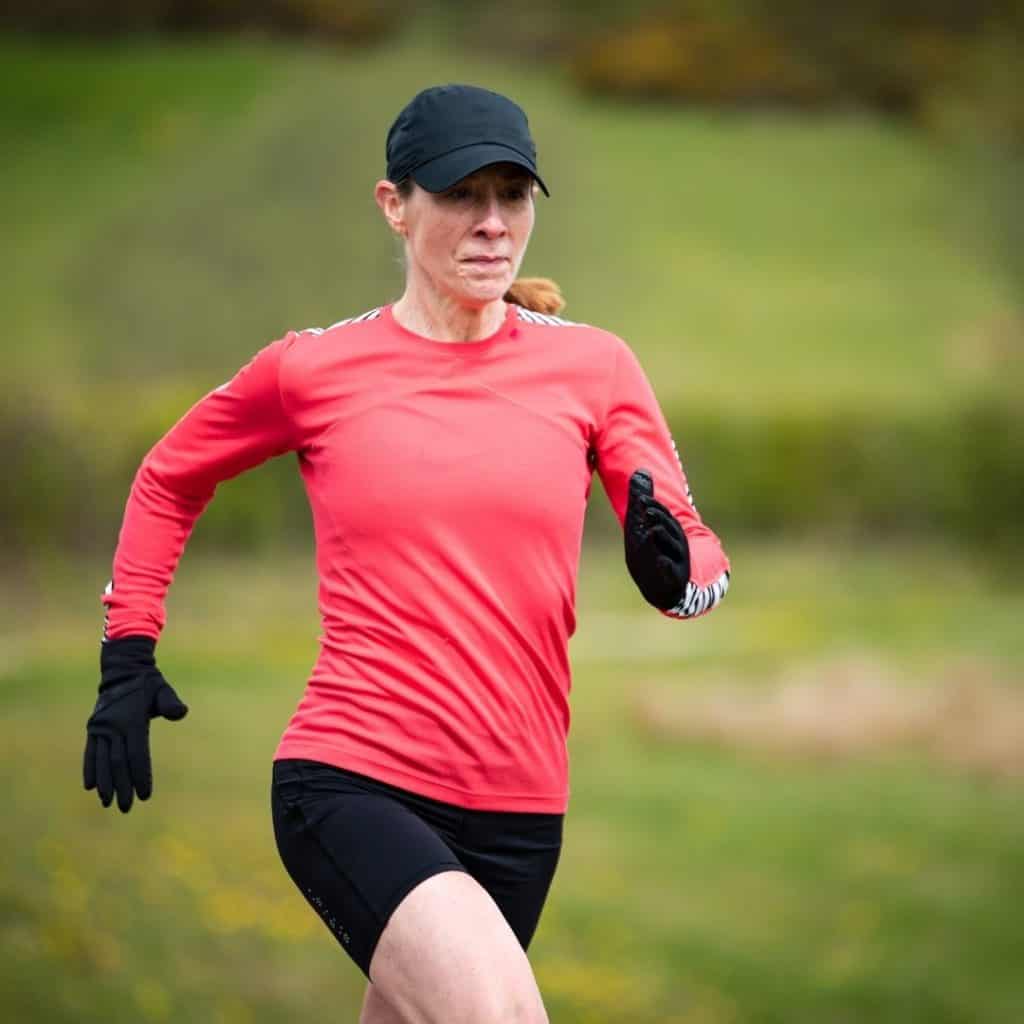
Join us for a free online presentation of the…
The Running Through Menopause Masterclass
…and discover how you can run well (and faster) as you get older, without training more or harder than you currently are, all while avoiding injury.
If it feels like you’re training harder than ever but not running the paces you’d like to be running or if you’re constantly tired, fatigued or running in some sort of pain, then this is specifically for you.
Save Your Seat In This Training Now…
If you made it this far, we’re pretty sure you enjoyed this article. If that is the case, you’re probably going to enjoy this one too! 10 Simple Ways To INCREASE Your Running Speed After 50.

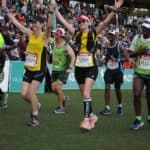

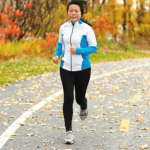
Comments are closed.